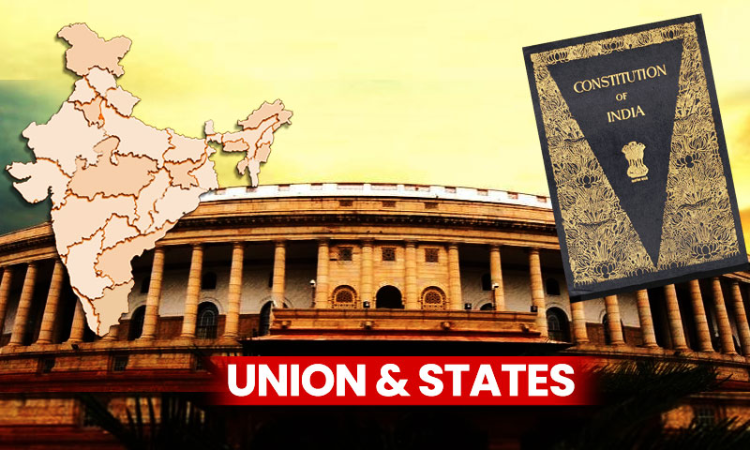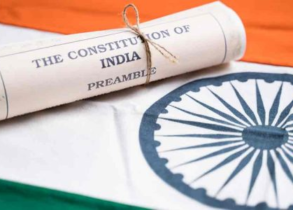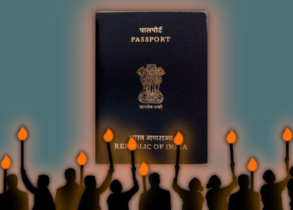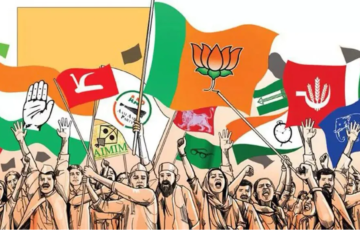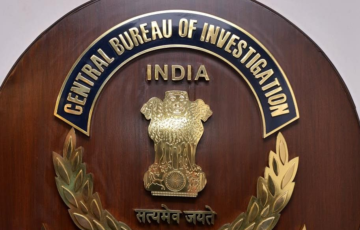UNION AND ITS TERRITORY
Introduction
- The “Union and its Territory” is a crucial aspect of the Indian Constitution, as it delineates the geographical and political boundaries of the nation. This section of the Constitution establishes the framework for the composition and organization of India as a federal and democratic republic. It defines how the Indian Union is structured and the territories that fall under its jurisdiction.
- The introduction to the “Union and its Territory” in the Indian Constitution lays the foundation for the country’s federal structure, which includes a strong central government and individual states or union territories. It delineates the principles governing the reorganization of states, the creation of new states, and the inclusion of territories into the Indian Union. Moreover, it reflects the commitment of the framers of the Constitution to maintain the unity and integrity of India while respecting the cultural, linguistic, and regional diversity of the nation.
Union of States
- Article 1 of the Indian Constitution defines India, or “Bharat,” as a “Union of States” rather than a “Federation of States.” This provision holds significance in two aspects: the name of the country and its political structure.
- Name of the Country: During the deliberations in the Constituent Assembly, there was no unanimity regarding the name of the country. Some members favored the traditional name, “Bharat,” while others advocated for the modern name, “India.” To reconcile this, the Constituent Assembly adopted a combination of both names, resulting in the official title “India, that is, Bharat.”
- Union of States: The term “Union of States” is chosen deliberately, even though India’s Constitution is federal in structure. Dr. B.R. Ambedkar explained this choice by highlighting two key reasons:
- Unlike the American Federation, where states formed a union through an agreement, the Indian Federation is not the result of a similar agreement among states. India’s unity is an inherent aspect of its existence.
- States within India do not possess the right to secede from the federation. The term “Union” underscores the indivisibility and indissolubility of India as a nation. The country is an integral whole, with the division into states being solely for administrative convenience.
- Territories of India:
- According to Article 1, the territory of India can be classified into three categories:
- Territories of the States: These are the regions governed by the state governments, and each state has its own government and legislature responsible for managing and legislating on matters listed in the State List of the Constitution.
- Union Territories: Union territories are directly administered by the Central government. The Constitution allows for the establishment of legislatures or councils of ministers in union territories as needed. Currently, India has nine union territories.
- Territories That May Be Acquired: India has the sovereign authority to acquire foreign territories through methods recognized by international law. These methods include cession (following a treaty, purchase, gift, lease, or plebiscite), occupation (territories unoccupied by a recognized ruler), conquest, or subjugation. India has historically acquired territories such as Dadra and Nagar Haveli, Goa, Daman and Diu, Puducherry, and Sikkim through these means.
- Parliament’s Powers:
- Article 2 empowers the Indian Parliament to admit new states into the Union of India or establish new states on terms and conditions it deems appropriate. This grants Parliament two distinct powers:
- Admitting states into the existing Union of India.
- Establishing entirely new states, which did not exist before.
- Notably, Article 2 deals with the admission or establishment of new states that are not already part of the Union of India. In contrast, Article 3 addresses the formation of or changes in existing states within the Union of India, focusing on the internal re-adjustment of territories among constituent states.
Parliament’s Power to Reorganize the States
- The Indian Parliament possesses the authority to reorganize states within the country, as outlined in Article 3 of the Indian Constitution. This article grants Parliament the power to initiate and execute the reorganization of states, subject to certain conditions and procedures. Some of the key aspects of the Indian Parliament’s power to reorganize states are listed below:
- Formation of New States: Parliament can create new states by separating territory from any existing state or by uniting two or more states or parts of states. It can also unite any territory with a part of any state.
- Alteration of State Boundaries: Parliament has the authority to alter the boundaries of any state within the Indian Union.
- Change in State Area: The power extends to increasing or diminishing the area of any state.
- Alteration of State Names: Parliament can change the name of any state.
- These powers allow Parliament to make significant changes to the composition, size, and boundaries of states within India.
- Conditions and Procedures: Article 3 imposes two essential conditions on the exercise of these powers:
- Presidential Recommendation: Before a bill proposing changes under Article 3 can be introduced in Parliament, it must have the prior recommendation of the President of India. This recommendation is a vital step in initiating the process of state reorganization.
- State Legislature’s Views: The President, before making a recommendation, must refer the proposed bill to the legislature of the concerned state for expressing its views. The state legislature is given a specified period within which to provide its views on the proposed changes.
- Importantly, while the views of the state legislature are sought, Parliament is not bound by these views, and it can either accept or reject them, even if they are received within the specified timeframe. Additionally, if amendments to the bill are made in Parliament, there is no requirement to seek fresh views from the state legislature.
- Territorial Integrity and the Constitution: It’s noteworthy that the Indian Constitution authorizes Parliament to form new states or alter the areas, boundaries, or names of existing states without requiring their consent. This means that the territorial integrity or continued existence of any state is not guaranteed by the Constitution. Consequently, India is often described as ‘an indestructible union of destructible states.’ In contrast, the U.S. Constitution guarantees the continued existence of its states, making the USA ‘an indestructible union of indestructible states.’
- Cession of Territory: The power of Parliament to diminish the area of a state under Article 3 does not encompass the authority to cede Indian territory to a foreign country. A 1960 Presidential reference to the Supreme Court clarified this distinction. To cede Indian territory to a foreign state, a constitutional amendment under Article 368 is required. As a result, the 9th Constitutional Amendment Act (1960) was enacted to transfer a specific territory, the Berubari Union in West Bengal, to Pakistan.
- However, the Supreme Court ruled in 1969 that the settlement of a boundary dispute between India and another country does not necessitate a constitutional amendment. Such a settlement can be achieved through executive action as long as it does not involve cession of Indian territory to a foreign country.
- In conclusion, Article 3 grants the Indian Parliament extensive powers to reorganize states, but these powers are subject to specific conditions and procedures. The Constitution’s stance on state reorganization and territorial integrity distinguishes India from some other federal systems, and it provides the flexibility to address administrative and geopolitical considerations within the country’s federal framework.
Exchange of Territories with Bangladesh
- The exchange of territories between India and Bangladesh, often referred to as the “Land Boundary Agreement,” was a significant bilateral agreement between the two countries. This agreement aimed to resolve long-standing border disputes and simplify the international border, leading to a more stable and harmonious relationship between India and Bangladesh. Here are the key points regarding this historic exchange of territories:
- Background: The land boundary between India and Bangladesh was characterized by several enclaves and adverse possessions, which were remnants of colonial-era territorial divisions. This complex border situation led to various issues, including the lack of clear demarcation, illegal immigration, and difficulties in administering these territories.
- Land Boundary Agreement: The Land Boundary Agreement between India and Bangladesh was signed on June 6, 2015, during Indian Prime Minister Narendra Modi’s visit to Bangladesh. It marked a historic milestone in resolving border disputes and strengthening relations between the two countries.
- Key Provisions:
- Under the agreement, India and Bangladesh exchanged territories, with India ceding a significant portion of land to Bangladesh, and Bangladesh ceding some territory to India.
- The exchange of territories aimed to rationalize the international border by ensuring that people living in enclaves and adverse possessions on one side of the border would become residents of the country on whose side their land was located.
- This exchange also included the transfer of several enclaves, adverse possessions, and territories that were previously under the jurisdiction of one country to the other.
- The Land Boundary Agreement sought to resolve disputes and simplify the border, making it easier for both countries to manage and secure their frontiers.
- Ratification:
- The Land Boundary Agreement required constitutional amendments in both India and Bangladesh to facilitate the exchange of territories. These amendments were ratified by both countries’ legislatures.
- India’s Parliament passed the 100th Amendment Act in 2015, which allowed for the exchange of territories with Bangladesh.
- Similarly, Bangladesh’s Parliament also ratified the agreement through a constitutional amendment.
- Benefits:
- The Land Boundary Agreement aimed to bring lasting peace and stability to the border region.
- It resolved the status of thousands of people who were previously stateless or living in enclaves without clear citizenship.
- The simplified border helped improve bilateral trade and cooperation between India and Bangladesh.
- This agreement symbolized a spirit of friendship and cooperation between the two countries and was seen as a model for resolving border issues peacefully.
- Conclusion: The exchange of territories between India and Bangladesh through the Land Boundary Agreement was a significant diplomatic achievement that not only resolved long-standing border disputes but also contributed to improved relations between the two countries. It aimed to bring lasting peace and stability to the border region and ensured that people living in these territories could enjoy the benefits of citizenship in their respective countries. This landmark agreement marked a positive step toward strengthening regional cooperation in South Asia.
Evolution of States and Union Territories
- Pre-Independence Era: At the time of India’s independence in 1947, the country was a complex tapestry of political units. There were two main categories of political entities:
- British Provinces: These regions were under the direct rule of the British government. They were governed by British-appointed officials and administrators.
- Princely States: India also included numerous princely states, which were ruled by native princes but were subject to the paramountcy of the British Crown. These princely states enjoyed varying degrees of autonomy.
- Post-Independence Scenario: The Indian Independence Act of 1947 led to the creation of two independent dominions, India and Pakistan. Additionally, the Act provided the princely states with three options:
- Joining India
- Joining Pakistan
- Remaining Independent
- Out of the 552 princely states within India’s geographical boundaries, a vast majority, numbering 549, chose to join India. However, three princely states—Hyderabad, Junagarh, and Kashmir—initially refused to join India. Over time, they were integrated into India through different means:
- Hyderabad was integrated through a police action.
- Junagarh’s accession to India was confirmed through a referendum.
- Kashmir formally acceded to India through the Instrument of Accession.
- Creation of States and Territories (1950): In 1950, the Indian Constitution classified states and territories into four categories: Part A, Part B, Part C states, and Part D territories. This classification encompassed a total of 29 units.
- Part A States: These comprised nine former governor’s provinces of British India, which included regions like Bombay, Madras, and Bengal.
- Part B States: These consisted of nine former princely states that had their own legislatures. Examples included Mysore, Hyderabad, and Travancore-Cochin.
- Part C States: This category encompassed former chief commissioner’s provinces of British India and some princely states that were centrally administered. There were a total of 10 Part C states.
- Part D Territories: The Andaman and Nicobar Islands were the sole entities in this category.
Reorganization Demands and Committees:
- While the integration of princely states was an ad hoc process, demands for reorganizing states based on linguistic considerations began to emerge, particularly from South India. To address this issue, the Government of India appointed the Linguistic Provinces Commission under K. Dhar in June 1948. However, this commission recommended state reorganization based on administrative convenience rather than linguistic factors, which caused dissatisfaction.
- As a result, a Linguistic Provinces Committee, popularly known as the JVP Committee, was formed in December 1948. This committee, consisting of Jawaharlal Nehru, Sardar Vallabhbhai Patel, and Pattabhi Sitaramayya, was tasked with reexamining the demand for linguistic reorganization. In its report submitted in April 1949, the JVP Committee rejected language as the basis for state reorganization.
- These early efforts and discussions laid the groundwork for future considerations of state reorganization, which eventually led to the reorganization of states along linguistic lines in the years to come.
The Emergence of Linguistic States:
- The year 1953 marked a turning point in India’s approach to state reorganization when the first linguistic state, Andhra Pradesh, was created by separating Telugu-speaking areas from the larger Madras state. This decision was prompted by a prolonged popular agitation and the tragic death of Potti Sriramulu, a prominent Congress leader, who had undertaken a 56-day hunger strike to demand the formation of Andhra state.
Fazl Ali Commission:
- The creation of Andhra Pradesh intensified demands from various regions for the establishment of states based on linguistic factors. Recognizing the need to address these growing linguistic aspirations, the Government of India appointed a three-member States Reorganisation Commission in December 1953, under the chairmanship of Justice Fazl Ali. The other two members of the commission were K.M. Panikkar and H.N. Kunzru.
Key Recommendations of the Fazl Ali Commission:
- The Fazl Ali Commission embarked on an extensive examination of the issue of state reorganization in India and submitted its report in September 1955. Some key recommendations and principles it outlined:
- Language as Basis: The commission significantly accepted language as the basis for the reorganization of states, acknowledging the importance of linguistic and cultural homogeneity.
- Unity of India: While recognizing linguistic and cultural factors, the commission also emphasized the paramount importance of preserving and strengthening the unity and security of the country. It argued that the unity of India should be regarded as a primary consideration in any state reorganization.
- Multiple Factors: The commission rejected the idea of a strict ‘one language-one state’ policy. Instead, it proposed a multi-faceted approach to reorganization, considering four major factors:
- Preservation of Unity and Security: Ensuring that state boundaries contribute to the unity and security of India.
- Linguistic and Cultural Homogeneity: Recognizing linguistic and cultural ties as an essential component but not the sole criterion.
- Financial, Economic, and Administrative Considerations: Taking into account practical aspects such as financial viability, economic resources, and administrative efficiency.
- Welfare and Development: Focusing on the welfare of the people in each state and the nation as a whole, considering economic development and social progress.
Impact and State Reorganization:
- The recommendations of the Fazl Ali Commission played a crucial role in shaping the subsequent reorganization of states in India. While the commission did not strictly adhere to the ‘one language-one state’ principle, it laid the groundwork for a more nuanced approach to state reorganization that balanced linguistic, cultural, and administrative considerations.
- In the years following the commission’s report, several states were reorganized or newly formed based on linguistic and cultural factors. This process addressed regional aspirations, promoted better governance, and facilitated the management of diverse linguistic and cultural regions within the Indian Union.
- The creation of linguistic states became a significant milestone in India’s journey toward greater administrative efficiency and regional identity, eventually leading to the emergence of states and union territories that align more closely with linguistic and cultural boundaries.
| Implementation of Fazl Ali Commission’s Recommendations |
The Fazl Ali Commission’s recommendations marked a significant shift in India’s approach to state reorganization. The commission proposed the abolition of the four-fold classification of states and territories that existed under the original Constitution. Instead, it advocated the creation of 16 states and three centrally administered territories in alignment with linguistic, cultural, and administrative considerations.
Union Territory: The Act also created the new Union Territory of Laccadive, Minicoy, and Amindivi Islands, which was detached from the Madras state. These reorganizations aimed to create more cohesive and administratively efficient states while taking linguistic, cultural, and geographical factors into account. In conclusion, the implementation of the Fazl Ali Commission’s recommendations through the States Reorganisation Act of 1956 led to a major restructuring of India’s states and union territories. This process sought to address linguistic and regional aspirations while maintaining the unity and security of the nation. It represented a significant milestone in India’s administrative history and played a pivotal role in shaping the country’s modern political map. |
India after the States Reorganisation Act of 1956
- New States
- Haryana (1966): Haryana was carved out of the eastern portion of the state of Punjab to create a separate state for the predominantly Hindi-speaking regions. Chandigarh was made a union territory and shared as a capital for both Haryana and Punjab.
- Himachal Pradesh (1971): Himachal Pradesh was formed by reorganizing the hilly regions of Punjab to create a separate state. Shimla was designated as its capital.
- Goa (1987): Goa was granted statehood in 1987, separating from the Union Territory of Goa, Daman, and Diu. This move recognized the distinct culture and identity of the Konkani-speaking people.
- Arunachal Pradesh (1987): Arunachal Pradesh was previously known as the North-East Frontier Agency (NEFA) and was granted full statehood in 1987, providing greater autonomy and representation to its diverse tribal population.
- Mizoram (1987): Mizoram became a separate state in 1987 after being part of Assam. This change reflected the aspirations of the Mizo people and their unique cultural and political identity.
- Chhattisgarh (2000): Chhattisgarh was carved out of the state of Madhya Pradesh to create a separate state. Raipur became its capital.
- Jharkhand (2000): Jharkhand was formed by separating the southern regions of Bihar to create a new state. Ranchi was chosen as its capital.
- Uttarakhand (2000): Uttarakhand, previously known as Uttaranchal, was created by dividing the state of Uttar Pradesh to better govern its hilly and mountainous regions. Dehradun became its capital.
- Telangana (2014): Telangana was carved out of the state of Andhra Pradesh on June 2, 2014, to become the 29th state of India. Hyderabad is the common capital for both Andhra Pradesh and Telangana until a new capital is established for Andhra Pradesh. The separation was driven by regional, cultural, and historical factors.
- New Union Territories:
- Chandigarh (1966): Chandigarh was designated as a Union Territory after it became the shared capital of Haryana and Punjab following the reorganization of Punjab in 1966.
- Daman and Diu (1987): Daman and Diu continued to be a union territory even after Goa was granted statehood in 1987.
- Puducherry (2006): The Union Territory of Puducherry, which includes Puducherry, Karaikal, Mahe, and Yanam, was renamed from Pondicherry in 2006.
- Lakshadweep (1973): Lakshadweep, formerly known as the Laccadive, Minicoy, and Amindivi Islands, was designated as a union territory in 1973.
- Dadra and Nagar Haveli and Daman and Diu (2020): On January 26, 2020, the Union Territories of Dadra and Nagar Haveli and Daman and Diu were merged to form a single union territory. This move aimed to optimize administrative efficiency and governance in the region.
- Ladakh (2019): Ladakh, located in the northernmost part of India, was created as a separate Union Territory along with Jammu and Kashmir on October 31, 2019. It is known for its stunning landscapes, including the Himalayan and Karakoram mountain ranges. Leh serves as its largest town and administrative center.
- Jammu and Kashmir (2019): On August 5, 2019, the special status of Jammu and Kashmir under Article 370 of the Indian Constitution was revoked, and the state was reorganized into two separate Union Territories – Jammu and Kashmir (with a Legislative Assembly) and Ladakh (without a Legislative Assembly). This move aimed to streamline governance and development in the region.
- These changes in administrative divisions aimed to address regional aspirations, enhance governance, and promote local development while maintaining the unity and integrity of the Indian Union.
| Territory of India | |
| States | Union Territories |
| Andhra Pradesh | Andaman and Nicobar Islands |
| Arunachal Pradesh | Chandigarh |
| Assam | Dadra and Nagar Haveli and Daman and Diu (formed in 2020 from the merger of two separate union territories) |
| Bihar | Delhi |
| Chhattisgarh | Jammu and Kashmir (from 31 October 2019) |
| Goa | Ladakh (from 31 October 2019) |
| Gujarat | Lakshadweep |
| Haryana | Puducherry |
| Himachal Pradesh | Andaman and Nicobar Islands |
| Jammu and Kashmir (until 31 October 2019) | Chandigarh |
| Jharkhand | Dadra and Nagar Haveli and Daman and Diu (formed in 2020 from the merger of two separate union territories) |
| Karnataka | Delhi |
| Kerala | Jammu and Kashmir (from 31 October 2019) |
| Madhya Pradesh | Ladakh (from 31 October 2019) |
| Maharashtra | Lakshadweep |
| Manipur | Puducherry |
| Meghalaya | |
| Mizoram | |
| Nagaland | |
| Odisha | |
| Punjab | |
| Rajasthan | |
| Sikkim | |
| Tamil Nadu | |
| Telangana | |
| Tripura | |
| Uttarakhand | |
| Uttar Pradesh | |
| West Bengal | |
| Andhra Pradesh | |
| Arunachal Pradesh | |
| Assam | |
| Bihar | |
| Chhattisgarh | |
| Goa | |
| Gujarat | |
| Haryana | |
| Himachal Pradesh | |
| Jammu and Kashmir (until 31 October 2019) | |
| Jharkhand | |
| Karnataka | |
| Kerala | |
| Madhya Pradesh | |
| Maharashtra | |
| Manipur | |
| Meghalaya | |
| Mizoram | |
| Nagaland | |
| Odisha | |
| Punjab | |
| Rajasthan | |
| Sikkim | |
| Tamil Nadu | |
| Telangana | |
| Tripura | |
| Uttarakhand | |
| Uttar Pradesh | |
| West Bengal | |
| Articles Related to Union and its Territory |
| Article 1: Name and territory of the Union |
| Article 2: Admission or establishment of new States |
| Article 3: Formation of new States and alteration of areas, boundaries or names of existing States |
| Article 4: Laws made by Parliament under articles 2 and 3 |

